You will find it interesting… and USEFUL… to read over an evaluation I wrote for a claim on a damaged painting. Some details and names have been eliminated of course.
The other day, I inspected a painting to evaluate the impact damage that occurred when movers weren’t watching a tight turn in a stairwell. The impact shattered the surface layer of paint, went through underlying layers of paint, causing sever cracking, paint loss and a puncture which also caused the fabric (cotton) to fray slightly. This damage is about 10 inches long.
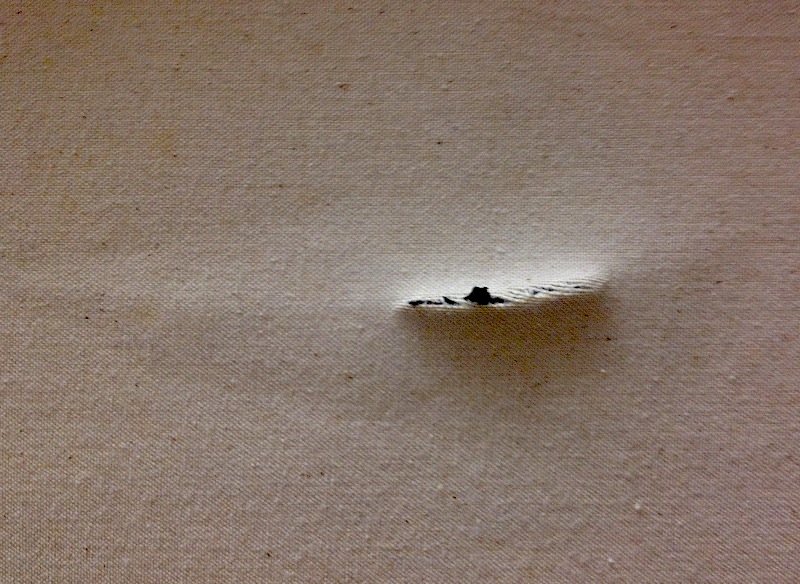
Reverse side of ripThe repair of the damage, with professional art conservation methods and ethics, will require the introduction of penetrating adhesives into the fractured layers in methods that are compatible with the technique of the painting so as not to effect any visible changes in the appearance of the surrounding areas. This consolidation will be of paramount importance for long term stability.
Once consolidated, the frayed/punctured/ripped artwork will be first consolidated. Then the fibers of the rip will be realigned and rejoined under magnification. Heat, humidity and local pressure will remove the distortion. However, if this type of local treatment ONLY is performed on the impact damage, this will not be a long term resolution. If a minimal treatment is desired then a slight pucker may have to be acceptable long term. It should also be said that the long term aging of this local area of impact may suffer continued deterioration of condition even IF the suggested repairs look perfect when completed. Patching a painting should NOT be an option as patching normally leads to a larger distortion/deformation in the future (sometime short term) and does not return the artwork to “pre-existing” or pre-damaged condition, a condition of performance for resolving fine art policy insurance claims. For a short YouTube video on the effects of patching, click here:
http://www.youtube.com/watch?v=xOk0vk3w5zs
Another very important condition to consider is the stress the impact has had on the paint layers. The layers of paint around the point of impact will surely age differently than the other surrounding areas thereby resulting in unsightly cracking patterns. There will be a very familiar bulls-eye-cracking pattern (or concentraited cracking) appear and continually get more aggravated and visible with time. Here are two examples:
The only way to avoid this type of development of the cracking patterns is to provide the substantial backing support of a properly designed lining. This overall backing process would provide the rigidity to inhibit the development of the otherwise inevitable cracking.
The stretcher bars are very poor quality for this size of painting, especially if lined. The stretcher bars do not expand and are too thin with inadequate cross bar support for a painting this size and with this much paint. We can try and make due with the original stretcher bars but the painting may not be optimally taut or the stretcher bars may warp when the lined painting is remounted.
On the reverse of the painting is the inscription by the artist which is very important to remain visible if a lining is applied. We normally trace/transfer these types of inscriptions, in the exact calligraphy of the artist and transcribe it in the same location as the original on the reverse of the new lining.
The proposed cost of the local repair would be 1/3 the price of the overall lining. One detail contributing to this factor is that the painting is oversized (over 48” in both directions) and the lining materials must be modified and be adapted.
If the lining art conservation treatment is chosen, the expected result would be a repair that will be not visible to the naked eye and will be stable for long term.
Scott M. Haskins, Art Conservator
Pres. FACL, Inc.
805 564 3438
faclartdoc@gmail.com
Please give this article a THUMBS up and leave a comment!
Keywords for this article: Ripped painting, damaged artwork, rip repair on painting, Scott M. Haskins, FACL, Inc., fine art policy insurance claim, pre-existing condition, art conservation, painting restoration, Fine Art Conservation Laboratories, patching a painting, bulls-eye-cracking pattern, concentraited cracking


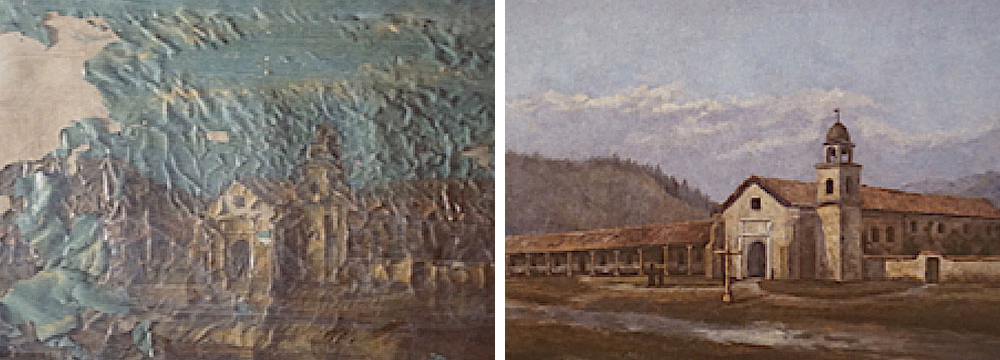

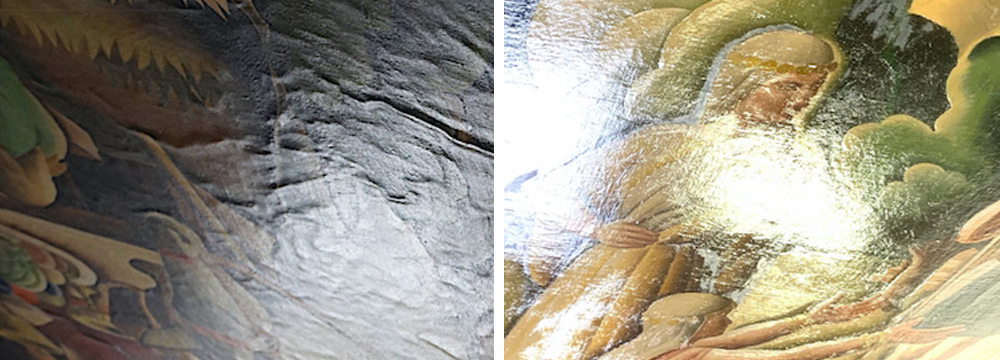

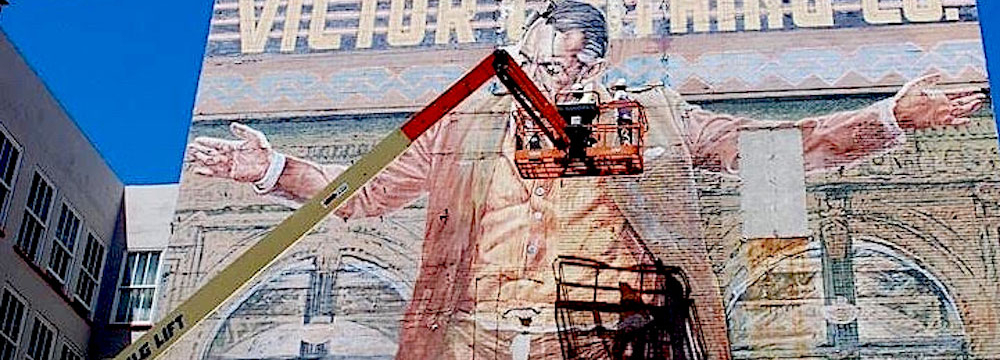
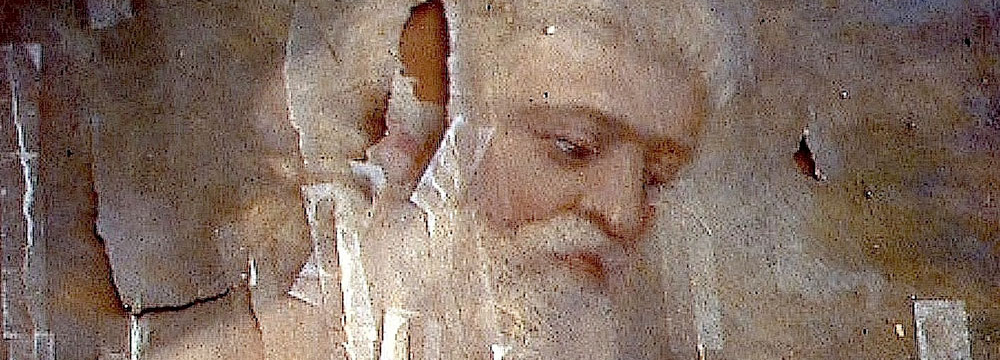
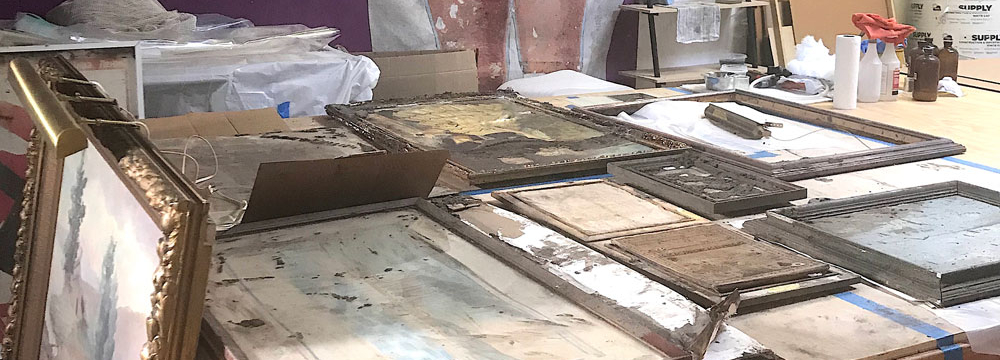

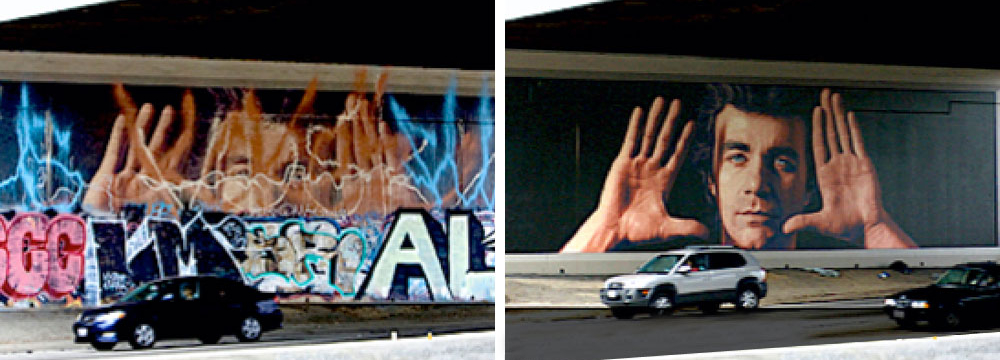



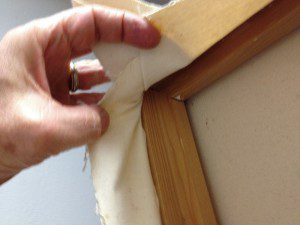

Wonderful example of the process, done right. Thanks.
Very intriguing post. It is clear you know what you’re talking about. That rip is huge. 10 inches long? I don’t understand how that even happens, but at least there are experts like you to fix problems like this.
The Real Person!
Author Scott M. Haskins acts as a real person and passed all tests against spambots. Anti-Spam by CleanTalk.
Thanks for leaving a note. We like working with Belfor. We feel honored that you trust us and consider us your experts.
Was there an insurance claim on this damage. Does the insurance company require
a lowest bidder? Or can I get a high bid and choose a lower bid and get some of my
premiums back?
The Real Person!
Author Scott M. Haskins acts as a real person and passed all tests against spambots. Anti-Spam by CleanTalk.
Shane, people settle with their insurance company, pocket the money and forgo the repair often. Also, the option you suggested is also common when the owner settles with the insurance company based on a bid then gets someone else to do it for less so he can pocket the difference. Insurance companies can find you an expert for estimates. This is true not only with repairing a painting but also repairing your roof. Caveat emptor, however!
Obviously, where you store or display a work of art might help avoid or make more
possible some type of damage. Any suggestions for avoiding damage when I’m
handling/storing art at home or at my office?
The Real Person!
Author Scott M. Haskins acts as a real person and passed all tests against spambots. Anti-Spam by CleanTalk.
Amy, taking care or looking ahead at possible damage is SO important and can save you all kinds of heartache and money. I use lots of sheets of cardboard and cardboard mirror boxes when moving and storing paintings. Actually, I buy and use a doubled walled cardboard. Be sure to not let the packing tape get on the frames; it will rip the finish off.
It seems so odd that professional movers would do something like this. Is this kind
of damage common? Do you have suggestions for choosing movers when there are
sensitive art items to be moved?
The Real Person!
Author Scott M. Haskins acts as a real person and passed all tests against spambots. Anti-Spam by CleanTalk.
Brandy, yes, this is common among the general commercial movers. There are movers, however, that are specialized art handlers. Look up on the internet a company in Los Angeles called Cookes Crating and see what their website says about their capabilities.
Great video on patching (or not patching) paintings! As a collector, I was unaware.
Thanks.
One of the benefits of working with FACL is their ability to do quality work on large
paintings. They often have really big paintings in the lab when I visit.
The Real Person!
Author Scott M. Haskins acts as a real person and passed all tests against spambots. Anti-Spam by CleanTalk.
Interesting that you should remember this, Taylor. We have one 6′ x 20’er and 1 7′ x 90’er in the lab right now. We have 3 6′ x 8′ arriving in the next couple of days! The lab is getting crowded (only temporarily).
I assume that you can make this damage disappear. But then, when it comes time
to resell the painting, how will the buyer know if its been damaged and repaired?
Wouldn’t it be worth less (like a car or an antique piece of furniture)?
We found a painting in storage that was very badly treated. We had Scott and FACL
work on it and while we were expecting a great result because of the excellent
referrals and comments from others, we were unprepared how fabulous it would
look. We were amazed!
When is damage to a painting like this covered on a home owner’s policy or when
do I need a separate art policy? We’ve started collecting but haven’t dealt with the
insurance coverage yet. Any suggestions?
The Real Person!
Author Scott M. Haskins acts as a real person and passed all tests against spambots. Anti-Spam by CleanTalk.
Roxanne, Great question. Well, that’s really a question for your insurance agent. But generally, collectibles of high value may not be covered. The insurance company may require what is called a “ryder.” That means a separate policy to cover just the collection. If your collectibles are not of high value or if they were inherited, then they may be covered in your home owner’s policy. Also ask your agent when you need to have an item appraised. Usually, there is a dollar amount that triggers the requirement for an appraisal. NOTE this subtlety: the insurance company may not require you to have an appraisal to sign up for the insurance BUT they will require the appraisal if you have a claim! If your item is, let’s say, stolen or lost in a fire… how are you supposed to get it appraised if it is missing?! So, obviously, if the insurance company requires an appraisal for a claim, you had better have it on file before the loss. For questions about these matters, you can call international art appraiser Richard Holgate and chat it up for free: 805 895 5121
I’m very pleased with the work FACL has dome on my artwork over the years and
recommend them always. The fact that they can fix damage like this is no longer
a surprise to me. A perfect repair is what I now expect from them and I am never
disappointed.
I love working with FACL. It is always a pleasure. They are so professional yet,
personable.
The Real Person!
Author Scott M. Haskins acts as a real person and passed all tests against spambots. Anti-Spam by CleanTalk.
Thanks Rachel. We appreciate your great attitude. Its always a pleasure to work with you.
Scott made me laugh the other day. I was stupefied that I could not find the 7” rip
that FACL had just repaired and I asked where it was (cause I couldn’t remember
exactly and picked out the wrong spot!). He said that if I can’t remember, he’s not
going to tell me!
The Real Person!
Author Scott M. Haskins acts as a real person and passed all tests against spambots. Anti-Spam by CleanTalk.
LOL, thanks for the comment Ted!
Would you work on this painting differently if it belonged to a private collector or a
dealer… or a museum?
We just picked up a painting from FACL and we were floored with its new found
beauty. We never imagined that the original painting was supposed to look this
wonderful. Thanks for your great quality work.
The Real Person!
Author Scott M. Haskins acts as a real person and passed all tests against spambots. Anti-Spam by CleanTalk.
You are welcome Kelly. Thanks for trusting us with your beautiful oil painting by Hanson Putuff. I glad you saw the work was worth the time and effort.
Everyone is just amazed at the beautiful work you did on our painting! Thank everyone at your office for the wonderful experience of working with you.
Everyone is just amazed at the beautiful work you did on our painting! Thank everyone at your office for the wonderful experience of working with you.
I drive 5 hours to meet with Scott and take him artwork to restore. Its always worth
the effort.
Thanks for giving us the insights of damage repair on fine art and claims. No one ever talks about this stuff and you make it very clear.
If this was being moved by professional movers then there is probably an insurance
company involved in paying for the repair. Do they choose the restorer or does the
owner get to choose a preferred person?
The Real Person!
Author Scott M. Haskins acts as a real person and passed all tests against spambots. Anti-Spam by CleanTalk.
The insurance company is usually happy when you provide a professional to help you as long as you will sign off on their repair. The insurance company has the obligation however to find you an expert, if you want, that will do quality work.
Impact cracks – bulls eye crack are so ugly because they stand out as a new element in the composition of design. If you love your artwork or are concerned about the value long term, let Scott and FACL take care of the art conservation treatments for you.
Its magic to me how you guys make this kind of ugly damage vanish. You are the best!
The Real Person!
Author Scott M. Haskins acts as a real person and passed all tests against spambots. Anti-Spam by CleanTalk.
Thanks Marie!
The paint layers in the photo look pretty thick. Does that make a difference in the potential of a painting to crack?
The Real Person!
Author Scott M. Haskins acts as a real person and passed all tests against spambots. Anti-Spam by CleanTalk.
Great question Claire. The cracking of a paint on a canvas painting CAN be due to many factors, among them, yes, the thickness of the paint… but this usually happens when an artist is experimenting with mixing new materials that don’t age well together (are not compatible). Other more common factors that cause cracking on canvas paintings are poor or unstable environment (wide humidity and temperature fluctuations) and poor handling and storage. When thick layers of paint begin to crack, however, their movement/instability is more severe. Here are two other posts on cracking that may interest you: and
We were so sorry this happened but are grateful that Scott and his company can make the damage disappear. Thanks for your help.